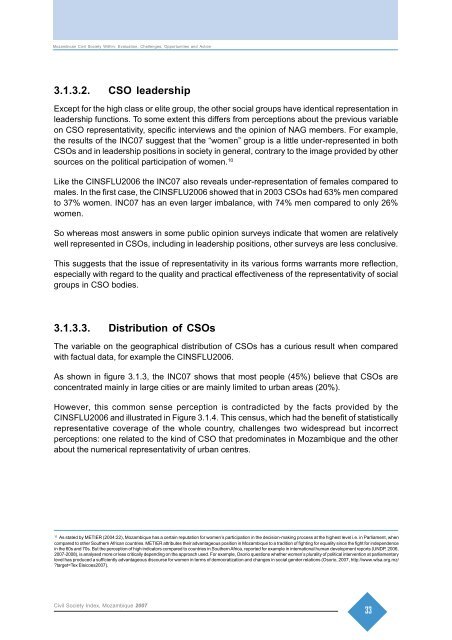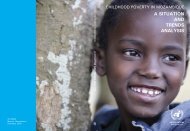Mozambican Civil Society Within: - UNICEF Mozambique - Home page
Mozambican Civil Society Within: - UNICEF Mozambique - Home page
Mozambican Civil Society Within: - UNICEF Mozambique - Home page
You also want an ePaper? Increase the reach of your titles
YUMPU automatically turns print PDFs into web optimized ePapers that Google loves.
<strong>Mozambican</strong> <strong>Civil</strong> <strong>Society</strong> <strong>Within</strong>: Evaluation, Challenges, Opportunities and Action<br />
3.1.3.2. CSO leadership<br />
Except for the high class or elite group, the other social groups have identical representation in<br />
leadership functions. To some extent this differs from perceptions about the previous variable<br />
on CSO representativity, specific interviews and the opinion of NAG members. For example,<br />
the results of the INC07 suggest that the “women” group is a little under-represented in both<br />
CSOs and in leadership positions in society in general, contrary to the image provided by other<br />
sources on the political participation of women. 10<br />
Like the CINSFLU2006 the INC07 also reveals under-representation of females compared to<br />
males. In the first case, the CINSFLU2006 showed that in 2003 CSOs had 63% men compared<br />
to 37% women. INC07 has an even larger imbalance, with 74% men compared to only 26%<br />
women.<br />
So whereas most answers in some public opinion surveys indicate that women are relatively<br />
well represented in CSOs, including in leadership positions, other surveys are less conclusive.<br />
This suggests that the issue of representativity in its various forms warrants more reflection,<br />
especially with regard to the quality and practical effectiveness of the representativity of social<br />
groups in CSO bodies.<br />
3.1.3.3. Distribution of CSOs<br />
The variable on the geographical distribution of CSOs has a curious result when compared<br />
with factual data, for example the CINSFLU2006.<br />
As shown in figure 3.1.3, the INC07 shows that most people (45%) believe that CSOs are<br />
concentrated mainly in large cities or are mainly limited to urban areas (20%).<br />
However, this common sense perception is contradicted by the facts provided by the<br />
CINSFLU2006 and illustrated in Figure 3.1.4. This census, which had the benefit of statistically<br />
representative coverage of the whole country, challenges two widespread but incorrect<br />
perceptions: one related to the kind of CSO that predominates in <strong>Mozambique</strong> and the other<br />
about the numerical representativity of urban centres.<br />
10<br />
As stated by METIER (2004:22), <strong>Mozambique</strong> has a certain reputation for women’s participation in the decision-making process at the highest level i.e. in Parliament, when<br />
compared to other Southern African countries. METIER attributes their advantageous position in <strong>Mozambique</strong> to a tradition of fighting for equality since the fight for independence<br />
in the 60s and 70s. But the perception of high indicators compared to countries in Southern Africa, reported for example in international human development reports (UNDP, 2006,<br />
2007-2008), is analysed more or less critically depending on the approach used. For example, Osorio questions whether women’s plurality of political intervention at parliamentary<br />
level has produced a sufficiently advantageous discourse for women in terms of democratization and changes in social gender relations (Osorio, 2007, http://www.wlsa.org.mz/<br />
?target=Tex Eleicoes2007).<br />
<strong>Civil</strong> <strong>Society</strong> Index, <strong>Mozambique</strong> 2007<br />
33
















